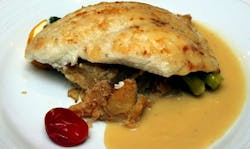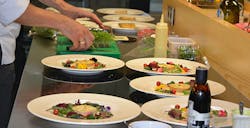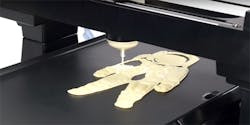The 3D Three: DIY Orthodontia Is Now a Thing
Here are the top three 3D printing stories of the month. They won't make you smarter, but will make you more interesting for about five minutes.
Brace Yourself
The adoption of 3D printing in the orthodontic industry is old news; however, a 24-year-old in New Jersey, Amos Dudley, has found a way to make it a cottage industry.
The digital designer wanted to fix his crooked teeth, and decided to turn it into one of the highest risk/ reward DIY projects ever attempted.
So what does one need to do this themselves? Knowledge of orthodontic movement, a 3D scanner, a mold of the teeth, CAD software, a hi-res 3D printer, retainer material, and a vacuum forming machine. I realized, I had - or could acquire - all of these things."
After reading up on modern orthodontic literature and seeing how professionals create 3D printed aligners, Dudley made a mold of his teeth. He bit into some putty, put it in yogurt container and created a cast using Permastone. That cast was laser scanned so Dudley could examine and manipulate the image to see how each tooth would move, an animation technique the pros use.
A 3D-printed retainer made by college student.
Photo: Amos Dudley
He used the Stratasys Dimension 1200es at his school, the New Jersey Institute of Technology, to create the aligner, then used a Formech 300 XQ vacuum forming machine to finish it. He cut the aligner to fit with an x-acto knife and smoothed the edges with a Dremel sander.
The results are pretty dramatic.
The cost of Invisalign could reach $8,000, and insurance only covers about $3,500. Ordering straighteners by mail can reach up to $2,100.
Even though this relatively cheap process (if you have the tools handy) could save you thousands, Dudley wisely recommends DO NOT try this at home.
Along with a straightened set of pearly whites, this DIY dental project landed Dudley a job with a 3D printing manufacturer, NPR reports.
Edible Arrangement
This chicken looks like it was prepared in the kitchen, but was actually 3D printed.
Photo: byFlow
Where would we be as a society without the microwave? The 20th century invention has allowed families to eschew the traditional monotony of sitting together at the dinner table to suffer through how each of their day went. Instead everyone can nuke a mac & cheese and then saunter off to their respective rooms to secretly binge watch “Fuller House.”
But why hasn’t science given us the freedom and convenience to choose our food the same way it lets us choose how we spend our six hours of evening TV viewing? Maybe it already has, if the people behind the byFlow Focus 3D printer have anything to say about it.
Last week at the 3D Food Printing Conference in Venlo, The Netherlands, the Dutch company used six of the 15-lb. portable, multi-material printers to create a five-course meal that included chicken and herbs. Using the raw materials, such as meat, cheese or chocolate and water as a binding agent, the printer can create intricate shapes to mimic traditional food. While this seems purely novelty at this point, the process allows for control of salt, fat and sugar content, without sacrificing taste.
Forget Farm to Table; Print-to-Plate Is the newest foodie trend.
Photo: 3dfoodprintingconference.com
Food Ink. is scheduled to visit Dubai, Seoul, Rome, Paris, Las Vegas, Toronto, Berlin, Singapore, and more in a tour promoting this advance in molecular gastronomy.
If you want to take the technology out for a test drive, try the PancakeBot, a 3D printer that extrudes batter in the shape of whatever you want. It’s $299, available at several retailers, and makes the perfect Mother’s Day present for guys who know nothing about women.
One small step for 3D printing... one giant leap for pancakes.
Photo: PancakeBot
The printing dimensions are 215 x 215 x 150 mm, so don’t expect to have one of these in your home to feed your family yet. It is interesting though, to imagine the convenience of a microwave while filtering out the unhealthy sodium and fat content prevalent in common “TV dinners.” It may not get us to start talking to each other again, but it could curb the obesity epidemic … until Cinnabon makes a 3D printer.
Plug-and-Play Robot Army
Using additive manufacturing to make food is cool, but could hardly be used to take over the world. MIT has figured out a way to 3D print fully formed miniature robots complete with hydraulic fluid for movement, which for aspiring super villains on a budget, is great news indeed.
“Our approach, which we call ‘printable hydraulics,’ is a step towards the rapid fabrication of functional machines,” says CSAIL Director Daniela Rus, who oversaw the project and co-wrote the paper. “All you have to do is stick in a battery and motor, and you have a robot that can practically walk right out of the printer.”
Screengrab: youtube/CSAIL
Here’s a video of the hexapod robot they created.
By hacking the 3D printer at the university’s CSAIL lab, researchers found a way to make one print head release liquid droplets into the build. Those are used to create fluid bellows that converts into mechanical force. The technique is detailed in the MIT paper here.
Creating one of these hexapods takes 22 hours, so it will be a while before someone creates an army of these to rob banks or the government employs them to monitor our every move, like in "Minority Report." My hope is that someone combines them with a 3D food printer so my burger can crawl right into my mouth, and I'll stop getting ketchup and mustard stains on my shirt.
Every fascist government worth its salt has a spider drone army.
Image: 20th Century Fox
About the Author
John Hitch
Editor, Fleet Maintenance
John Hitch, based out of Cleveland, Ohio, is the editor of Fleet Maintenance, a B2B magazine that addresses the service needs for all commercial vehicle makes and models (Classes 1-8), ranging from shop management strategies to the latest tools to enhance uptime.
He previously wrote about equipment and fleet operations and management for FleetOwner, and prior to that, manufacturing and advanced technology for IndustryWeek and New Equipment Digest. He is an award-winning journalist and former sonar technician aboard a nuclear-powered submarine where he served honorably aboard the fast-attack submarine USS Oklahoma City (SSN-723).








